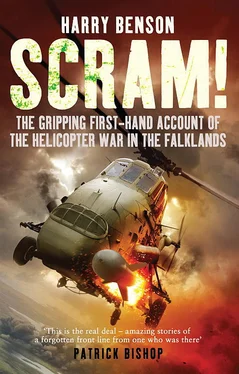It hadn’t been a thing of beauty. But I’d get better at it, much better.
After a few circuits and landings, Jackson unstrapped and climbed out of the cockpit onto the flight deck, leaving me and Steve Larsen to it. We then did a few circuits and landings on our own before he jumped back in and we flew back to shore.
The following night we repeated the process, this time in the dark. Night deck landings are far more unnerving. On the approach to the ship, I had to keep flicking my eyes from the flight instruments to the lights on the ship. It’s much harder to judge distance and speed just from a couple of vertical lights on top of the ship and a row of horizontal lights behind the flight-deck officer’s head. But at least there’s no swooshing water to distract you. Instead of watching the ship roll around, I learnt to keep a steady hover whilst watching the row of flight-deck lights rolling around.
For my first day deck landing I had somehow managed to avoid a nasty effect known as ‘ground resonance’. Wessex were especially prone to this problem. Just because of the slightly lopsided way helicopters hang suspended in the hover, landing almost always involved bouncing from one wheel to the other. Left unchecked this bouncing can degenerate rapidly into ground resonance, an unstable condition that can eventually cause the helicopter to topple over. If the bouncing isn’t too bad, lowering the full weight of the helicopter onto the deck usually solves the problem. On my subsequent deck landings, I went into ground resonance a few times and we had to lift quickly back up into the air to calm things down. Experienced pilots almost never get into ground resonance. Unfortunately both aircrew and groundcrew knew this. So it was embarrassing when it happened.
Compared to landing, taking off from the little Green Rover , or indeed from any ship’s flight deck, was a piece of cake. It was much the same procedure in reverse. First I gave a thumbs-up sign to the flight-deck officer. The four groundcrew ran in and removed the strops, moved clear of the disk, then turned and held them up clearly for me to confirm. The flight-deck officer signalled I was clear to launch by holding his bats out again. I didn’t want to hang around on a pitching and rolling deck for long after that, pulling in power cleanly and decisively to lift off. As the Wessex continued rising, I cleared to the left and accelerated away from the ship.
After sleeping on the floor of Ascension for two nights, Nick Foster and his team were hugely impressed with the comfort and splendour of the RFA Fort Austin . It was as big as a medium-sized cruise chip, with cranes and gantries where cabins might otherwise have been, and it had some of the comforts of a cruise ship. As flight commander, Foster had a cabin to himself, complete with double bed, sea view, ensuite bathroom and even shared use of a steward. The maintainers also thought it was great because they were each assigned two-man cabins. The low point of the trip was undoubtedly when the chief steward was forced to apologise. The normal seven-course sit down dinner would be reduced to a mere five courses, since they didn’t know how long they would be away. ‘If you’re going to go to war,’ thought Foster, ‘go to war on an RFA.’ It was luxurious compared to the cramped conditions of a Royal Navy warship.
On 9 April, after embarking a 120-strong combined group of SAS and SBS special forces, Fort Austin became the first British ship to set off south from Ascension. At first there was a vague notion that Fort Austin, Endurance and its two AS12 air-to-surface missile-equipped Wasp helicopters might comprise a sufficient task group to retake South Georgia. Fortunately, in the absence of a Navy warship to act as escort, this unwise idea was vetoed.
Three days out from Ascension, Fort Austin met up with Endurance in the rough South Atlantic waters. Lieutenant Kim Slowe took off in Yankee Delta to begin the ‘vertrep’, vertical replenishment, of eagerly awaited fresh food and stores across to Endurance . Unfortunately, part way through the vertrep, a fuel computer malfunction on the Wessex caused one of the engines to run down to idle. Slowe felt the aircraft begin to sink because of the lack of power. To the horror of the hungry Endurance onlookers, he was forced to jettison the load into the sea just to stay airborne, and then coolly flew the Wessex on one engine back to Fort Austin .
The following night, Nick Foster took off in Yankee Delta to test the repaired aircraft. All seemed as well as it ever does on a night flight over the sea when you can see little or nothing outside and only the dimly lit instruments inside your cockpit. Soon after take-off the computer on the same engine ran down to idle yet again. In the dark night of the South Atlantic, Foster felt the tail of the aircraft start to shake badly. ‘Oh God, I think we’ve got a tail rotor problem,’ he told his crewman. His mind immediately switched to the prospect of ditching into the sea. It only lasted a few seconds before he realised that in fact the adrenalin of the situation was making his knees shake. The movement on the pedals was in turn making the tail shake. Rather less coolly, Foster recovered safely on one engine to Fort Austin , which was now heading back north to Ascension.
Meanwhile, in the North Atlantic, Jack Lomas and Oily Knight were heading south with their Wessex gunships on RFA Resource . Having been the first to embark up in Scotland, it soon became apparent that they had departed in haste: for the AS12 missiles to be effective, the M260 missile sight in the left seat of each aircraft needed to be recalibrated. Fortunately, a few days later, Resource was sailing past the Dorset coast: Lomas and Knight returned back to Yeovilton for the necessary adjustments and rejoined the ship on the same day. The two gunships carried out a successful test-firing of four missiles just before arrival in Ascension.
Like Nick Foster in Fort Austin , Jack Lomas was going to war in style. Resource was essentially an ammunition ship. In other words, a giant bomb. Soon after heading off, the ship’s captain told Lomas about his approach to action stations. ‘There’s two ways we can play this, Jack,’ he said. ‘We can be totally pucker, strip down the wardroom, close the bar, and take it all terribly seriously like Hermes . Or we can be sensible. We are sitting on 27,000 tons of high explosive. If an Exocet missile gets us, the next bang you hear will be your arse going through your head. You won’t need a lifejacket. You’ll need a parachute.’
The bar stayed open. Throughout the journey south, the Wessex team lived and dined like kings. This provided an irresistible opportunity for one-upmanship to Oily Knight. It was already a depressingly murky day when Knight flew across to the aircraft carrier Hermes in search of spares. After shutting down on the huge deck behind a row of Sea Harriers, he headed towards the little door at the foot of the superstructure and went below decks.
He was appalled by the cramped conditions he met on board the aircraft carrier. There were bodies asleep on camp beds along the corridors. Lunch on board appeared little short of dumplings and some sort of gruel. Returning to Resource , he typed up a ‘typical’ dinner menu, embellished ever so slightly with lobster, foie gras, steak and salmon, cheese, biscuits and liqueurs, washed down with port. The menu was then despatched to a ‘friend’ on the junglie Sea King squadron on Hermes . Knight knew that morale was already low. He was delighted to hear that on receipt of his menu it had now plummeted below the floor. Taking the piss was all part of the game, according to Knight. Thankfully for the rest of us, his moment of comeuppance lay ahead.
Читать дальше












